The Why and How of STEM
A MiddleWeb Resource Roundup
In the six months that STEM Imagineering blogger Anne Jolly has shared her expertise in STEM learning with MiddleWeb readers, she has delved into the theory and the practice, with an emphasis on what works for teachers and students in the classroom. In this Resource Roundup we provide an overview of STEM, gather some of Anne’s resources into one place, and add some new finds.
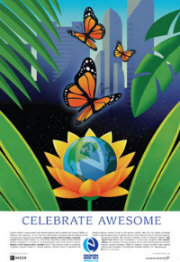
STEM Is for Everyone
Now is STEM’s national moment, according to Ben Esner, the Director of the Center for K-12 STEM Education at the Polytechnic Institute of NYU. Writing for the Huffington Post, Esner argues that the STEM focus on investigation and problem solving, hands-on project learning, and interdisciplinary studies results in a powerful methodology for effective education across content areas. The implementation of Common Core State Standards will reinforce STEM, he predicts, while the coming Next Generation Science Standards will necessitate the further development of STEM educational resources along with easily available professional development for educators. Esner sees the need for schools to move beyond reliance on institutions such as his, and begin to gain the support and develop the expertise to create and teach curriculum that is driven by engineering design principles.
Outreach Biologist DNLEE tackles the challenge of democratizing STEM education in her Scientific American post, A Dream Deferred: How access to STEM is denied to many students before they get in the door good. She recounts seeing how “lack of resources, benign discouragement by well-meaning adults, and active exclusion by powerful gatekeepers” severely limited urban high school students’ access to science fair participation, even as she worked to open it. Her observations underscore the social prejudices and cultural barriers that face economically disadvantaged children.
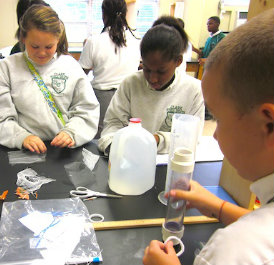
Balancing the challenge of making STEM accessible to everyone is the benefit of STEM learning for everyone, especially students whose success in the traditional classroom has varied. Read Anne Jolly’s take in her blog post, Three Ways STEM Levels the Field.
STEM: The Concept
Writing in a National Science Teacher Association post, Albert Einstein Distinguished Educator Jonathan Gerlach begins with a definition of STEM:
STEM education is an interdisciplinary approach to learning where rigorous academic concepts are coupled with real-world lessons as students apply science, technology, engineering, and mathematics in contexts that make connections between school, community, work, and the global enterprise enabling the development of STEM literacy and with it the ability to compete in the new economy.” (Tsupros, 2009)
Gerlach goes on to discuss two challenges educators face. First, how do teachers move beyond the traditional siloing of subjects and work together to understand how technology and engineering can mesh with math and science? Second, how do educators relate to the business community’s understanding of STEM, which he describes as more oriented to recruiting graduates who can immediately begin to solve problems on the job as opposed to newly minted workers who arrive with extensive technical knowledge but less hands-on experience? He also notes that graduates of tech schools as well as university engineering and other professional schools will be in demand for the wide range of STEM occupations.
…Math and Science
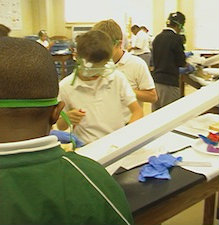
…Technology
One aspect of the technology component of STEM is covered in Learning Science Through Computer Games and Simulations, another 2011 publication from the National Academies Press. For a hands-on look at the intersection of games and education, visit Gamedesk.The California nonprofit, supported by the Gates Foundation, the NFS, and others, is expanding its scope across the country by creating a national digital learning platform with funding from AT&T. Already visitors to the site can try out Thermbot targeting middle graders and Motion Math In-Class for elementary students. Also consider the research underway into games-based assessment at the University of Wisconsin-Madison. The NSF-funded project, based at the Games+Learning+Society Research Center, has already resulted in games with STEM characteristics, involving players in worlds that explore regenerative biology, virology and limnology.
…Engineering
Look into engineering in yet another National Academies Press book, 2009’s Engineering in K-12 Education: Understanding the Status and Improving the Prospects. It’s also in paperback and downloadable formats. The book “reviews the scope and impact of engineering education today and makes several recommendations to address curriculum, policy, and funding issues. The book also analyzes a number of K-12 engineering curricula in depth and discusses what is known from the cognitive sciences about how children learn engineering-related concepts and skills.” For a briefer and more “how-to” treatment of engineering’s place in K-12 STEM instruction, visit this page from TeachEngineering, a site packed with searchable lessons, activities and units with input from many universities and professional societies through NSF grants.
Moving from Understanding to Implementation
With an better grasp of the scope of STEM, educators can begin to incorporate its principles into their classrooms. But just how do teachers learn the pedagogical skills and strategies to bring STEM alive for students? STEM Imagineering blogger Anne Jolly recently asked teacher trainer Judy Duke about the steps to successful STEM professional development. You can read the key elements here.
A veteran middle grades educator, turned teacher coach, Duke works with the non-profit Engaging Youth through Engineering (EYE), based in Mobile, Alabama. The EYE project, a school-community program of the Mobile Area Education Foundation, combines resources from a major NSF grant, area educational institutions, philanthropists, and corporations to produce STEM curriculum designed to engage middle school students in coursework that will prepare them for high tech careers. An organization with which STEM Imagineering blogger Anne Jolly consults, EYE shares STEM materials at its website, including a graphic of its Engineering Design Process. Also online: videos of students immersed in STEM learning and overviews of EYE modules for grades six through eight.
Other Sources of STEM Curriculum and Fun
At the PBS Kids Design Squad Nation website, middle grades teachers can access a guidebook that starts with a how-to to explain the design process and continues with 11 activities based in engineering. Design Squad Nation no longer appears on the PBS broadcast schedule, but episode videos, animations and other activities from DSN and its predecessor Design Squad (hold the Nation) are available. One goal of the program was to get beyond the stereotype of the engineer.
PBS also provides a wide range of helpful links at its STEM Education Resource Center. In addition to lessons and activities, the resource center offers a long list of links to major resources from the International Society for Technology in Education (ISTE), National Science Foundation, National Science Teachers Association and more. Public TV tackles math along with other STEM topics for middle graders at STEM Collaborative. In addition to collecting highly interactive math activities from several state public TV organizations, the collaborative lists lots of other free STEM resources for K-12.
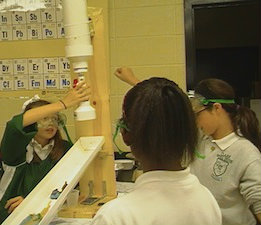
For up-to-the-minute STEM news, browse the blogs collected by Best Colleges Online. You will also find STEM education organizations on Twitter @StemEdCoalition, @TeachingSTEM and @STEMAhead, along with STEM-related hashtag groups: #nsta, #scichat, #scienceed, #edtech, #stem, #scied, #STEMchat and #stemed. Science NetLinks shares a collection of STEM-related apps here. This is their K-12 list, but you can filter it by grades. Another option: STEM Magazine published by a STEM educator in Georgia.
And don’t miss STEM Career SmartBrief, free from the Association for Career and Technical Education (ACTE). It covers what students can look forward to in STEM as well as topics on middle and high school STEM learning. See a copy and sign up here.
Should STEM Morph into STEAM? STREAM?
Writing in Edutopia, John Maeda, President of the Rhode Island School of Design, makes the case for extending the effectiveness of STEM by transforming it into STEAM, to add the creativity of the arts and artistic design to the push for STEM. Maeda notes the need to support arts education and includes links to organizations which are considering the impact of STEAM.
In a guest post at MiddleWeb’s STEM Imagineering blog, educator Sammy Parker argues, “From the lives and words of Nobel laureates to the eye-opening changes that the arts have on students, especially low-SES ones, to the dynamism and success of classrooms and other educational settings that meld the best of both worlds, the evidence for the immense value of creating and cultivating a nexus of the arts and STEM is persuasive.”
Commenting on a recent eSchool News article, “STEAM’ education gains momentum in schools: A growing number of experts say the arts should be included in STEM education initiatives, a writer raises a concern seen elsewhere: “Ideally it should be STREAM–adding an R for reading or literacy. Math, science, technology and the arts must include reading and writing. Learning these different content areas includes learning to read/write in these areas too. We can’t forget reading!”
In a Huffington Post article, Chuck Cadle, CEO of Destination Imagination, a nonprofit provider of STEM education in afterschool programs, says “Bottom line is that educators need to recognize that STEM is not a stand-alone educational strategy. STEM knowledge should be integrated across the curriculum,” using inquiry based learning, whole child and other strategies “to foster higher-order thinking skills, such as goal setting, planning/budgeting, organizing, prioritizing, memorizing, initiating/risk-taking, shifting, and self-monitoring.”
 Gadget Alert
Gadget Alert
You can power up STEM projects with littleBits, according to teacher Lisa Noble. Writing at Voices from the Learning Revolution (scroll to the end), she describes the little motors, marketed as “an opensource library of electronic modules that snap together with magnets for prototyping, learning and fun.” MIT Media Lab’s Joi Itos includes littleBIts in trends for 2013. Educators get a 15% discount: “pricey but way cool” according to MiddleWeb’s John Norton, who also points to Lego’s Mindstorms gadgets, popular in well-funded STEM circles. Both gadget lines would make nice donations to local schools.
Update (May 2014): Visit the January 30, 2014 issue of ASCD Express centered on Generation STEM for these articles and more: Inquiry-Based Instruction Explores, Then Explains by Jeff Marshall, The Four Cs of Next Generation Engineering Standards by Matthew Vick, and The Art of Thinking Like a Scientist by Lisa Yokana.

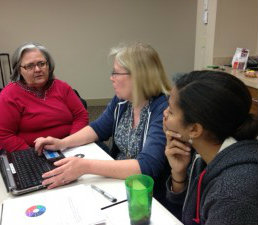


































I really like this collection of resources! You’ve organized STEM resources into usable strands, and I am planning to work from the bottom up . . . what’s not to love about a “Gadget Alert?” Thanks, thanks!
Anne
“The Why and How of STEM | MiddleWeb” truly causes me imagine
a small bit further. I cherished every individual portion of this blog
post. Thanks for the post -Lanora